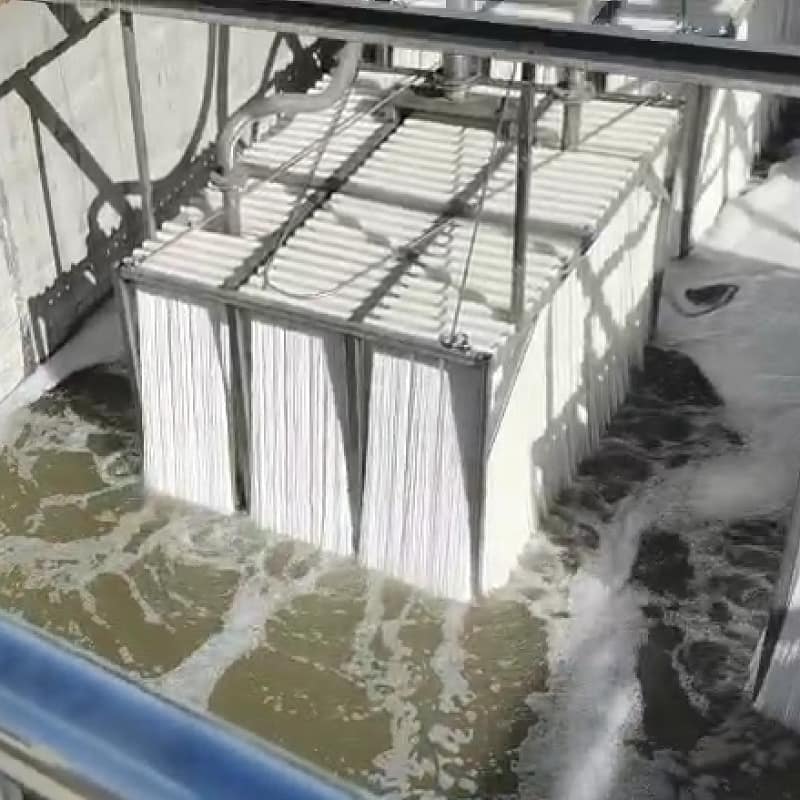MBR (Membrane Bioreactor) technology is an innovative wastewater treatment process that integrates membrane filtration technology with biological treatment processes. The use of MBR technology and membrane separation allows for the retention of activated sludge and large organic molecules in the bioreactor, effectively replacing the secondary settling tank. This increases the concentration of activated sludge, providing enhanced biological treatment while allowing separate control of Hydraulic Retention Time (HRT) and Sludge Retention Time (SRT).
The implementation of MBR technology has revolutionized the efficiency of wastewater treatment systems, leading to more sustainable practices.
Through the combination of membrane filtration and biological treatment, the MBR process significantly enhances the performance of wastewater treatment systems. Compared to traditional biological treatment methods, MBR systems offer several advantages, including:
- High biochemical efficiency
- Strong resistance to shock loading
- Stable effluent water quality
- Reduced footprint
- Extended sludge discharge cycles
- Ease of automation and control
As one of the most promising technologies in wastewater treatment, MBR systems provide efficient and reliable solutions for various industries and applications. Below, we explore the key functions of MBR technology and important considerations for its usage.
- Process Flow Overview
- Traditional Process Flow: Raw Water → Screening → Equalization → Primary Settling Tank → Anaeration Tank → Aeration Tank → Secondary Settling Tank → Sand Filter → Effluent
- MBR Process Flow: Raw Water → Screening → Equalization → Anaeration Tank → Aeration Tank → Membrane Bioreactor Tank → Effluent
- Traditional Process Flow: Raw Water → Screening → Equalization → Primary Settling Tank → Anaeration Tank → Aeration Tank → Secondary Settling Tank → Sand Filter → Effluent
- Preventing Membrane Fouling and Cleaning Guidelines
- Material: PVDF
- Fiber Diamater(mm): 1.0(ID)/2.1(OD)
- Suggested Flux Rate L/(m²·h): 10〜25
- Material: PVDF
- Membrane Module Performance Parameters
- RANDL Environment offers different models to meet different requirements from clients
- RANDL Environment offers different models to meet different requirements from clients
- Hydrophilic Treatment of Membranes
- Typically, membranes are hydrophilic before shipment, but if not immediately used after treatment, they should be sealed to maintain moisture in the fibers.
- Typically, membranes are hydrophilic before shipment, but if not immediately used after treatment, they should be sealed to maintain moisture in the fibers.
- Preventing Membrane Fouling and Cleaning Guidelines
- Maintain Moisture: Membranes must be kept moist at all times. If they dry out, irreversible damage to the membrane components may occur.
- Handle Chemicals with Care: NaOH (sodium hydroxide), hydrochloric acid, and sodium hypochlorite are highly corrosive. Operators should wear appropriate protective equipment, such as rubber gloves, protective suits, helmets, and goggles, to avoid direct contact.
- Sodium Chloride Solution: Sodium chloride has strong oxidizing properties and should only be used when acid-base cleaning is insufficient. Prolonged use of sodium chloride can negatively impact membrane lifespan.
- Ensure Adequate Aeration: During the membrane absorption process, ensure that adequate airflow is maintained beneath the membrane. Do not operate self-priming pumps when the blower is turned off.
- Proper Cleaning Pressure: When flushing the membrane surface with tap water, increasing pressure can improve cleaning efficiency. However, excessive pressure should be avoided to prevent damage to the membrane.
- Avoid Overloading: When handling lower flow capacities, it is recommended to maintain a 24-hour average discharge rate. Avoid operating at excessive flow rates over short periods to ensure membrane longevity.
- Maintain Moisture: Membranes must be kept moist at all times. If they dry out, irreversible damage to the membrane components may occur.
- Transportation, Storage, and Handling
- The transport and storage conditions of membranes and equipment must ensure that the environment temperature is maintained within the range of 5°C to 40°C to prevent membrane damage.
- Membranes should not be exposed to direct sunlight, as UV rays can degrade the engineering plastics used in the membrane components.
- If the on-site environment is below 0°C, it is advised to select hydrophilic membranes. If not used immediately after hydrophilic treatment, membranes should be sealed and stored to ensure the fibers remain moist and free from freezing during the cleaning process.
- The transport and storage conditions of membranes and equipment must ensure that the environment temperature is maintained within the range of 5°C to 40°C to prevent membrane damage.
Conclusion: Maximizing the Efficiency of Your MBR System
In conclusion, the MBR (Membrane Bioreactor) technology is an advanced and highly efficient solution for wastewater treatment, offering numerous advantages like high treatment efficiency, compact design, and low maintenance. However, to fully realize its potential, it’s crucial to avoid common misconceptions and understand the system’s actual capabilities and limitations.
By maintaining proper operation, adhering to best practices for membrane cleaning and maintenance, and designing the system according to specific needs, you can ensure that your MBR system operates at optimal efficiency for years.
At RANDL Environment, we specialize in providing tailored MBR solutions designed to meet diverse needs, ensuring superior water quality and reliable performance. If you’re looking to implement MBR technology or optimize your existing system, feel free to contact us for expert guidance and support.

